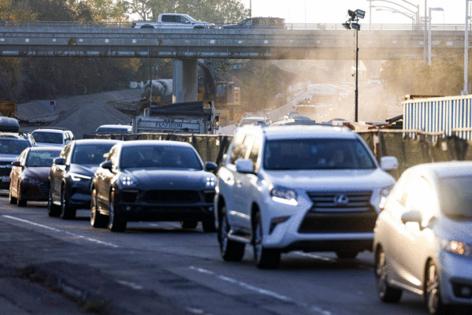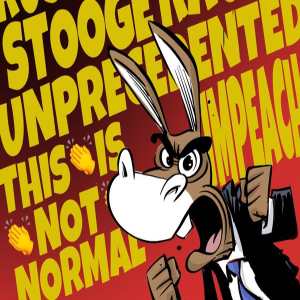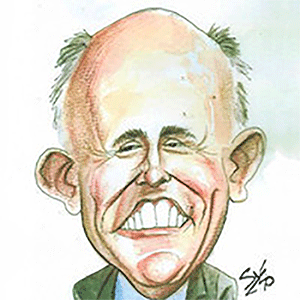Should California drivers get charged by the mile? A pilot program is looking into it
Published in News & Features
The California Department of Transportation is crunching the data from a pilot program it wrapped up earlier this year that addresses one of the most controversial topics in the Golden State — creating a per-mile road charge that drivers across California would pay.
Backers say it’s worth considering because revenue collected from the primary source of funding for roads and highways — the per-gallon excise tax charged at gas stations — keeps declining because of more fuel-efficient cars and trucks and the growth in adoption of electric vehicles.
The pilot project by the department, known as Caltrans, is designed to explore completely replacing the excise tax on gasoline with a road charge.
But some critics worry the state will keep the excise tax in place in some form or another, and that a newly created road charge will simply add to the heavy tax burden Californians already shoulder.
To help pay for maintaining and upgrading the state’s roads and highways, California’s gasoline excise tax charges drivers 59.6 cents per gallon. That’s the highest gas tax in the country, with Pennsylvania coming in second at 57.6 cents a gallon.
Despite that, California’s Legislative Analyst’s Office foresees “notable revenue declines” of some $5 billion over the next decade from the state’s gasoline excise tax if the state stays on track to meet its carbon reduction goals.
Under an executive order issued by Gov. Gavin Newsom nearly five years ago, no new gasoline-powered vehicles will be allowed to be sold in California by 2035.
In addition, starting with model year 2026, at least 35% of manufacturers’ new passenger car and truck sales must be electric vehicles, plug-in hybrids or hydrogen-fuel cell vehicles, known as ZEVs (zero-emission vehicles) for short. The percentages step up each year until hitting 100% in 2035.
California already accounts for the largest number of electric vehicles and plug-in hybrids of any state in the country, with ZEVs making up 25% of all new car sales last year.
Since electric vehicles and hydrogen fuel-cell vehicles don’t run on gasoline, that drives down the amount of revenue generated by the state’s excise tax.
And because of higher fuel efficiency standards, gas-powered cars and trucks get better mileage than they used to. That means drivers make fewer trips to the gas station, further driving down collections from the excise tax.
The Legislative Analyst’s Office, in its December 2023 report, anticipated revenue from the gasoline excise tax falling 64% compared to what was collected 10 years prior.
Budgets in other states are feeling the pinch, too. The National Association of State State Budget Officers recently reported that motor fuel taxes raised 35.9% in transportation revenue in fiscal year 2024, down from 41.1% in 2016.
In 2021, the California Legislature passed and Newsom signed Senate Bill 339 that established a pilot program “to identify and evaluate” the issues in creating a road charge.
Caltrans conducted the pilot, lining up 800 drivers of either gasoline or electric passenger vehicles to “drive normally” from August 2024 through the end of January of this year and report how many miles they racked up.
The drivers could choose among several methods to report their mileage — a monthly reading of their odometers, a plug-in device or in-vehicle telematics.
Participants were split into two rate groups — one with a flat per-mile fee of 2.8 cents per mile or one with an individualized fee based on the miles-per-gallon fuel economy of their vehicles.
“A potential road charge tax is meant to address the way we collect revenue and not as a backdoor to increase the burden on motorists,” Caltrans spokesperson Chris Clark said in an email to The San Diego Union-Tribune.
The data from the pilot project is now being compiled and analyzed. As per the provisions of SB 339, Caltrans will present a final report to the Legislature no later than the end of next year.
Another study just came out
Last month, a nonprofit advocacy group for the transportation construction industry released its own study.
“Transportation infrastructure is the backbone of how we live and move in the state,” said Kiana Valentine, executive director of Transportation California, based in Sacramento. “So this seemed like the natural next step for us to get involved in terms of helping policymakers address this situation.
The 131-page analysis, conducted by NEWROAD Consulting, identified three “viable funding options” for the state to consider.
The first would expand the current pay-at-the-pump tax model to include EVs and hydrogen fuel-cell vehicles. But the report acknowledges the complexity of folding in a wider variety of vehicle generation, as well as the challenge of capturing at-home EV charging.
A second option: Replace all fuel taxes with a “pure” road user charge that would make drivers of all types of vehicles pay, based solely on the distance traveled. While straightforward, the report admits this option would require “significant investments in technology” to track each vehicle and also raises concerns about how the charge would be enforced and who would do it.
The third pathway opts for a mixed model that would combine gasoline (and diesel) fuel taxes at the pump with a road user charge for zero-emission vehicles. This option would allow for a gradual transition for policymakers to work out fairness and equity concerns, but the report said “challenges remain,” including what to do with out-of-state vehicles.
Valentine said there are tradeoffs with each of the three options and thus far her group has not endorsed one over the others. “I think we are still in an exploratory phase of trying to figure out which one would fit best within the state of California,” she said.
Transportation California was a major supporter in the passage of 2017’s Senate Bill 1 that spends $5.4 billion each year on roads, freeways, bridges, transit programs and safety efforts.
The San Diego Association of Governments proposed instituting a road user charge under former SANDAG Chief Executive Officer Hasan Ikhrata. But the fee of 3.3 cents per mile traveled received strong pushback and the SANDAG board in September 2023 ditched the plan on a 15-4 vote.
In an email last month to constituents, San Diego County District 5 Supervisor Jim Desmond called the SANDAG mileage fee “an outrageous idea” and voiced opposition to creating a statewide road user charge.
“Let’s be clear: this debate shouldn’t be about electric vehicles versus gas-powered cars — it should be about government overspending,” Desmond said. “We already pay for our roads through sky-high gas taxes, registration fees and even property taxes. Yet Sacramento continues to spend irresponsibly.”
When the Legislature passed SB 339, then-Senate Minority Leader Scott Wilk, a Republican, sent Newsom a letter, urging the governor to veto the bill.
While acknowledging the state’s transportation system and the gas tax that supports it “are fundamentally broken,” Wilk said a mileage charge would make things worse for California drivers who have long commutes.
“As long as we fail to build housing in adequate supplies to house our workforce near their jobs, then the working poor are still going to be paying far more in vehicle-miles traveled fees than their wealthy counterparts,” Wilk wrote.
Steven Greenhut of the Pacific Research Institute, a think tank based in Pasadena that espouses free-market solutions to policy issues, thinks a mileage tax is a good idea — in theory.
“The state has a legitimate concern that the gas taxes are running out in order to pay for road maintenance,” he said. “From a free-market perspective, a user fee based on how much the driver uses the road makes a lot more sense.”
But Greenhut said the state would need to make sure the mileage fee completely replaces the gasoline excise tax so that drivers don’t end up getting “double-taxed.”
“I just think that the Legislature has proven to us over years that it’s never seen a tax it doesn’t want to increase,” he said. “I’m skeptical of whether the state will actually get rid of the gas tax.”
Other states have started experimenting with mileage charges.
In Utah, drivers of electric vehicles or hybrids pay an annual fee of $143.25 or they can voluntarily enroll in the Utah Road Usage Charge Program and pay 1.11 cents per mile. Drivers in the program will never pay more than $143.25 in a given year, which benefits motorists who drive less.
Enrollees can report their mileage through telematics that automatically records the distance traveled by the vehicle or by taking a photo of their odometer every three months. Utah transportation officials said as of last year, about 20% of eligible drivers had signed up.
Oregon and Virginia have similar voluntary programs in place.
In July, Hawaii will start phasing in a mileage-based road usage charge that applies only to drivers of electric vehicles. The charge will eliminate Hawaii’s annual $50 registration fee for EVs, with the odometer checked each year when vehicles are inspected. By mid-2028, all EV drivers will be automatically enrolled.
(Steven Greenhut is a member of the editorial board of the Southern California News Group, which is owned by Media News Group, the owner of The San Diego Union-Tribune.)
©2025 The San Diego Union-Tribune. Visit sandiegouniontribune.com. Distributed by Tribune Content Agency, LLC.







Comments